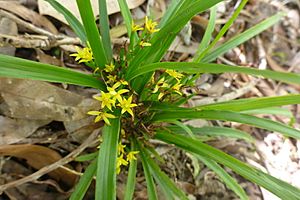Yellow grass orchid facts for kids
Quick facts for kids Yellow grass orchid |
|
|---|---|
 |
|
| Apostasia wallachii growing near Cairns | |
| Scientific classification | |
| Genus: |
Apostasia
|
| Species: |
wallichii
|
| Synonyms | |
|
|
The yellow grass orchid, also known as Apostasia wallichii, is a special kind of orchid. It grows naturally in many parts of the world. You can find it in India, Japan, China, Southeast Asia, New Guinea, and northern Australia. This orchid has many dark green leaves that look like grass. It also has up to forty small, yellow flowers that look like stars. These flowers grow on a stem with branches. The yellow grass orchid usually lives in wet forests and rainforests.
Contents
About the Yellow Grass Orchid
The yellow grass orchid is a plant that grows in the ground. It has tubers, which are like small, round storage parts underground. This plant is an evergreen herb, meaning it stays green all year. It might not look like a typical orchid at first glance.
Roots and Stems
This orchid has thin, branched roots. These roots have small, bumpy parts that are fleshy. The plant also has a straight, strong stem. Many grass-like leaves grow in whorls (circles) along this stem.
Leaves and Flowers
The leaves are dark green, thin, and feel a bit like leather. They are about 100–200 mm (4–8 in) long and up to 1 mm (0.04 in) wide. The yellow grass orchid produces between five and forty yellow flowers. These flowers look like small stars and are about 8–10 mm (0.3–0.4 in) wide. They grow on branched stems that are 50–100 mm (2–4 in) long. These flowering stems grow from where the leaves meet the main stem (called leaf axils).
Flower Parts
Each flower has three sepals and three petals. Sepals are like small leaves that protect the flower bud. Petals are the colorful parts of the flower. For this orchid, all six parts are similar in size and shape. They are about 4–6 mm (0.16–0.24 in) long and 1–1.5 mm (0.04–0.06 in) wide. They are narrow and triangular, and all are yellow.
Flowering Time
In Australia, you can see these orchids bloom between December and March. In China, they usually flower in August.
Naming the Yellow Grass Orchid
The scientific name for this plant, Apostasia wallichii, was first officially described in 1830. A botanist named Robert Brown wrote about it. His work was published in a book called Plantae Asiaticae Rariores, written by Nathaniel Wallich. The second part of the name, wallichii, was chosen to honor Nathaniel Wallich. This is a common way to name new species.
Where the Yellow Grass Orchid Lives
The yellow grass orchid grows in warm, wet places. It likes tropical forests and rainforests. Sometimes, you can find it growing near streams. It can grow at high places, up to 1,000 m (3,000 ft) above sea level.
Global Distribution
This orchid is found in many countries. These include Hainan and south-west Yunnan in China, Bangladesh, Cambodia, India, Indonesia, southern Japan, Nepal, Malaysia, Myanmar, Sri Lanka, Thailand, Vietnam, and the Philippines.
Australian Distribution
In Australia, it grows in Queensland. You can find it in areas between Bamaga and Ingham.
See also
 In Spanish: Apostasia wallichii para niños
In Spanish: Apostasia wallichii para niños

